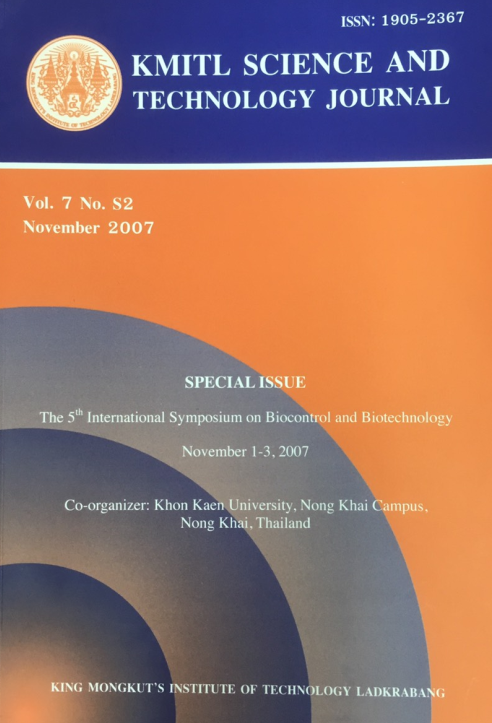CHITIN OLIGOMERS PRODUCTION FROM FUNGAL MYCELIUM CULTIVATING ON CASSAVA STARCH MEDIUM
Main Article Content
Abstract
The morphologies and growths of Monascus sp. KB20M1, Mucor rouxii and Rhizopus oligosporus were studied on MYS medium containing cassava starch as a C-source and the maximum dry mycelium weights were produced by the condition of 250 rpm of rotary shaker at 30oC for 7 days, which gave the yields of 11.24, 8.08 and 8.15 g/l, respectively. The analysis of FT-IR spectrophotometer on fungal mycelium of the three-species showed the composition of chitin-chitosan by the detection of amide I group (1640-1660 cm.-1) and hydroxyl group (2920- 2930 cm.-1). The chitin oligomers production was performed on fungal mycelium hydrolysis by biological method (chitinase) and chemical method (phosphoric acid). The retrieved product of chitin oligomers were varied due to the hydrolysis conditions and time-period. The O1 and O2 samples from enzymatic digestion and O3 sample from the chemical digestion were selected for further study of biological activity on Phalaenopsis growth. It was found that chitin oligomers enhanced the survival and rooting of Phalaenopsis. Phalaenopsis which was immersed in the O2 sample at the concentration of 1000-time dilution for 3 hr presented the maximal growth (p<0.01). The survival and rooting was found at 100% and the average length of rooting was about 94.00 mm.
Keywords: chitin oligomers, chitooligomers, fungal mycelium, Phalaenopsis
Corresponding author: E-mail: kksomcha@kmitl.ac.th
Article Details
Copyright Transfer Statement
The copyright of this article is transferred to Current Applied Science and Technology journal with effect if and when the article is accepted for publication. The copyright transfer covers the exclusive right to reproduce and distribute the article, including reprints, translations, photographic reproductions, electronic form (offline, online) or any other reproductions of similar nature.
The author warrants that this contribution is original and that he/she has full power to make this grant. The author signs for and accepts responsibility for releasing this material on behalf of any and all co-authors.
Here is the link for download: Copyright transfer form.pdf
References
[2] Muzzarelli, R.A.A. 1996. Chitosan-Based Dietary Foods. Carbohydrate Polymer, 29, pp. 309-316.
[3] McMurrough, I. and Bartnicki-Garcia S. 1973. Inhibition and Activation of Chitin Synthesis by Mucor rouxii cell Extracts, Archive Biochemistry Biophysics, 158(2), pp. 812-816.
[4] Rokem, J.S., Klein D., Toder H. and Zomer E. 1986. Degradation of Fungal Cell Walls Tking into Consideration the Polysaccharide Composition, Enzyme Microbiology Technology, 8(10), pp. 588-592.
[5] Hirano, H. and Nagao N. 1989 Effects of Chitosan, Pectic Acid, Lysozyme and Chitinase on the Growth of Several Phytopathogens, Agricultural Biological Chemistry, 53, pp. 3065-3066.
[6] Hirano, S., Iwata M., Yamanaka K., Tanaka H., Toda T., Inui H. 1991. Enhancement of Serum Lysozyme Activity by Injecting a Mixture of Chitosan Oligosaccharides Intravenously in Rabbits, Agricultural Biological Chemistry, 55, pp. 2623-2625.
[7] Inui, H., Tsujikubo M., and Hirano S. 1995 Low Molecular Weight Chitosan Stimulation of Mitogenic Response to Platelet-Derived Growth Factor in Vascular Smooth Muscle Cells. Bioscience Biotechnology Biochemistry, 59, pp. 2111-2114.
[8] Tokoro, A., Tatewaki N., Suzuki K., Mikami T., Suzuki S., and, Suzuki M. 1988 Growth-inhibitory Effect of Hexa-N-Acetylchitohexaose and Chitohexaose Against Meth-A Solid Tumor. Chemistry Pharmaceutical Bulletin, 36, pp. 784-790.
[9] Roby, D., A. Gadelle, and A. Toppan. 1987. Chitin Oligosaccharides as Elicitors of Chitinase Activity in Melon Plants. Biochemistry Biophysics Research Community, 143, pp. 885-892.
[10] Bezouska, H., Sklenar J., Dvorakova J., Havlicek V., Pospisil M., Thiem J., Kren V. 1997. NKR-P1A Protein, an Activating Receptor of Rat Natural Killer Cells, Binds to the Chitobiose Core of Uncompletely Glycosylated N-linked Glycans, and to Linear Chitooligomers. Biochemistry Biophysics Research Community, 238 (1), pp. 149-153.
[11] Samain, E., Drouillard S., Heyraud A., Driguez H., Geremia A. 1997. Gram-scale Synthesis of Recombinant Chitooligosaccharides in Escherichia coli. Carbohydrate Research, 302, pp. 35-42.
[12] Aiba, S., Krairak, S., Sashiwa, H., Yamano, N., Ishikawa, K., Shimomura, A., Kawabata, G., Hiraga, H. and K. Oda. 2003. Production of N-acetyl-D-glucosamine from Chitin Using Crude Enzymes Derived from Trichoderma viride and Aeromonas hydrophila H-2330 9th International Chitin-Chitosan Conference. Montreal, Quebec, Canada, pp. 260-266
[13] Aiba, S. 1997. Preparation of N-Acetyl-Chitooligosaccharides by Hydrolysis of Chitosan with Chitinase Followed by N-Acetylation. Carbohydrate Research, 265, pp. 323-328.
[14] Sashiwa, H., Fujishima S., Yamano N., Kawasaki N., Nakayama A., Muraki E., Hiraga K., Oda K. and Aiba S. 2002. Production of N-Acetyl-Glucosamine from α-Chitin by Crude Enzymes from Aeromonas hydrophila H-2330, Carbohydrate Research, 337 (8), pp. 761-763.
[15] Krairak, S. and Budda, N. 2002. The Production of Short Chitin Oligomer by Chitinolytic Microorganism, The 5th Asia-Pacific Chitin-Chitosan Symposium & Exhibition. Bangkok, Thailand., pp. 371-379.
[16] Yongsmith, B., Krairak, S. and Bavavoda, R. 1994. Production of Yellow Pigments in Submerged Culture of a Mutant of Monascus spp, Journal of Fermentation Bioengineering, 78(3), pp. 223-228.
[17] Krairak, S and Budda, N. 2004. The Chitin Degradation by the Resting Cell of Chitinolytic Microorganism. Kasetsart Journal (Natural Science), 38, pp. 36-44.
[18] Jia, Z. and Shen D. 2002. Efffect of Reaction Temperature and Reaction Time on the Preparation of Low-Molecular-Weight Chitosan using Phosphoric Acid, Carbohydrate Polymers, 49(4), pp. 393-396.


